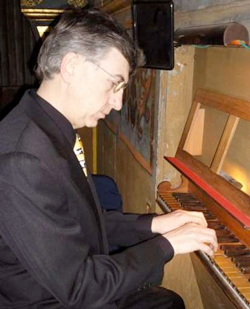by Timothy Robson

The exact origin of Bach’s Pedalexercitium, BWV 598 (Pedal “exercise” or “study”) is unclear. The brief pedal solo, lasting fewer than two minutes, may be a fragment of a lost work, an exercise for Johann Sebastian Bach’s son, C.P.E. Bach, or an exercise composed by C.P.E. himself, etc. It takes a bit of cheekiness to “improve upon” J.S. Bach, but to open his program Edoardo Bellotti offered his own Improvised Fantasia on Pedal Exercitium, BWV 598, expanding the original into a much larger work, with an opening toccata incorporating the pedal solo, then adding a convincing fugue with contrasting subjects. It is the sort of thing that would have commonly occurred with Baroque composers—the creation of a new work from borrowed, pre-existing materials.
Bellottii continued down the same musical recycling path with his own transcription of Antonio Vivaldi’s four-movement Concerto, “La Notte” Op. 10/2. It was played as chamber music, on relatively soft and transparent registrations featuring flute stops and soft principals. Bach, of course, transcribed several of Vivaldi’s concertos, and Bellotti’s new transcription is an attractive addition to that repertoire. Here as elsewhere in this recital, Bellotti exhibited rhythmic flexibility and attention to phrasing that brought the music alive. His performances were not completely recording-note-perfect, but the intense musicality of his playing easily trumped any minor fluffs along the way.
Bach’s Toccata, Adagio and Fugue in C Major, BWV 564, received a similar treatment to the Vivaldi concerto transcription — Bellotti played it like chamber music. Its brilliant toccata with a demanding pedal solo is followed by an adagio with a lyrical, ornamented melody, and a rousing jig-like fugue. Although the outer two movements are often performed on full organ registrations, Bellotti chose to use softer registrations instead, which enabled the listener to hear the inner details of the music. The milder stop combinations also allowed for more brisk tempos in the toccata and fugue. His reinterpretation proved that there is never just one way to play Bach’s music.
Bellotti closed the first part of the program with Bach’s Fantasia in G minor, BWV 542, notable for its striking use of chromaticism before its climactic moment. A fugue, also in G minor, is often paired with this fantasia, but there is conflicting evidence that the two movements belong together. Bellotti played only the fantasia, with its recitative-like quality and twists and turns, choosing to end with a giagantic major chord rather than the usually-played minor chord.
After intermission (a welcome break, due to the beautiful, warm spring weather and the stuffy church sanctuary), Bellotti offered Bach’s organ Trio Sonata in E-flat Major, BWV 525. Bach wrote the six trio sonatas as teaching pieces for his second-eldest son, Wilhelm Friedemann. They are a challenge to even the most accomplished player: a single independent voice in each hand and pedal, the musical equivalent of patting one’s head and rubbing one’s stomach. There is nowhere to hide in the transparency of the music — errors are instantly apparent. Bellotti played with sure technique and solid rhythm. The slow second movement is in two repeated sections; on the repeats, Bellotti added stylish ornamentation. Again, he used simple registrations of flutes and principals.
Bernardo Pasquini (1637-1710), a prolific composer both of keyboard works as well as operas, oratorios and cantatas, is relatively unknown to modern audiences. Edoardo Bellotti played his Passacaglia in G minor. Unlike most such pieces, in which a repeating bass theme supports a set of variations, Pasquini’s theme is modified throughout the course of the work, creating a much richer harmonic palette. Here, in a charming performance, Bellotti showed more of the colors of the organ, especially a buzzy Cromhorne reed stop and the mutation stops which sound at non-unison pitches.
Another Bach favorite closed the announced program, the Prelude and Fugue in D major, BWV 532, which opens with a treacherous, exposed, ascending D major pedal scale. Bellotti nailed it and went on to a masterful performance of the prelude, with just the right amount of fantasy mixed with a solid pulse. He took the tricky fugue at a good clip, with great success.
Improvisation is a skill shared both by organists and jazz musicians. Bach was a master improviser, as are French organists, who are known for their supremely inventive improvisations during Mass, when repertoire is rarely performed. What is more unusual is improvisation in Baroque style. Edoardo Bellotti was given two musical themes upon which to improvise, neither of which had he seen before they were handed to him in an envelope. They turned out to be famous: the Lutheran chorale tune Nun komm der Heiden Heiland and the subject of the final choral fugue in Bach’s Mass in B minor, Dona nobis pacem.
Bellotti improvised a chorale prelude on the chorale tune, with an accompaniment of repeated chords supporting a highly ornamented melody line. At the conclusion of the chorale prelude, he moved directly into a well-constructed fugue based on the Dona nobis pacem theme. It did seem a bit unfair to give him the theme of another fugue that happens to be one of the supreme achievements in Western music, but Bellotti’s creation was convincing in its mastery of pure Baroque style.
Published on ClevelandClassical.com April 21, 2015.
Click here for a printable copy of this article



